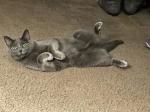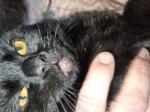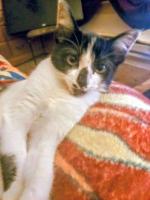Cat Fact Sheet
Here's another cat fact sheet with some tidbits and trivia that I've collected from various sources. Some of these are obvious, and some perhaps not so well known.
Rough Tongues and Meat, Cat Claws and Feet
- Cats tend to have short jaws, giving their bite lots of power. To kill prey, a bite into the neck with the canine teeth will do it. The cat will hold on until the animal suffocates.
- Cats have thick hair around the pads of their feet, which allows them to remain silent while walking.
- Unlike many animals, felines walk on their toes, enabling them to start into a run at any moment.
- With a large kill, cats in the wild use their rough tongues to separate meat from bone.
- Cats will often eat the entire body of small prey, crushing and ingesting bones for calcium, along with any vegetation the prey has consumed.
Odd Facts about Cats
- Cat species are found throughout the world.
- Cats are good climbers and climb high into trees quickly. They get stuck in trees because their backward pointing claws don't help them to go down, only up.
- All cats have a territory, including indoor cats. If you notice your cat pacing the house, she's probably on patrol.
-
When your cat rubs against you, she is actually marking you with her scent. Cats that live together will exchange scents with each other regularly, forming a communal scent.
If one of your cats comes back from the veterinarian smelling funky, this can cause unrest in the house, and even some hissing. Starting with the cat that was not at the vet, rub everybody with the same cloth several times to spread the scent around.
Cat Grooming Facts
- Cats spend up to a third of their waking hours grooming themselves.
- A cat can reach almost every part of its body with its barbed tongue.
- Cats groom more actively (and sometimes over-groom) when they are anxious. It tends to help them relieve tension. They also groom to cool off in hot weather and after activity.
- Cats love to sun bathe, and sunlight on the fur produces vitamin D. During grooming the fur provides vitamin D nourishment.
- During self-grooming, scratching with the back legs helps to dislodge any parasites from the fur and skin. It also helps to get the difficult to clean areas of the head, neck, and shoulders.
Taste and that Sandpaper Tongue
- Adult cat tongues have rows of hooked, backward-pointing projections called papillae. These barbs latch onto food and fluids, and give the cat's tongue a sandpaper feel. Newborn kittens only have papillae around the edge of the tongue.
- Cats drink fluids by curling their tongues into the shape of a spoon. The barbs on their tongues help scoop the water as they flick it to the backs of their mouths, swallowing every few laps.
Perky Ears and Sweet Sounds of Mice
- Your cat can hear more than one sound at a time, and can independently rotate each ear 180 degrees, thanks to more than 20 muscles on each side.
- People can hear up to 20,000 cycles per second, but cats can hear up to 65,000 cycles. The sound of mice chatter is about 40,000 cycles per second. So the next time your cat perks her ears up and you don't hear anything... well, you figure it out!
The Right Feline Touch
- Cats don't have to have direct contact in order to actually feel. Cats can judge distances between objects, the width of an opening, and changes in temperature and air pressure. Beneath your cat's skin are sensors that can detect heat and cold, drafts, and slight changes in pressure.
- Cats are heat seekers, which explains why they're avid sunbathers. Cats are drawn to heat so much that they've been known to burn their fur before turning away from a heat source.
- The noseleather and the paw pads are the most sensitive areas on the cat to the touch. Cats can judge a rise or fall in temperature as minimal as one or two degrees.
- Whiskers act like antennae. They help judge distance, and changes in air pressure.
- When it's too dark to see well, whiskers are used to navigate. They can be used to judge the size of openings. First the whiskers, then the head. Since the feline collarbone is loose, a cat can crawl through a space the width of its head.



Comments: What do you think?
Have your say about what you just read. Leave me a comment in the box below.